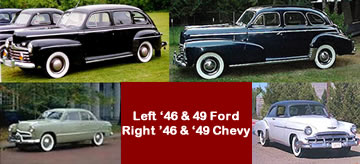
Post World War II America

Norman Rockwell's Homecoming
The World in 1945. In 1945 the people of all nations had to reckon with the fact that in the span of about three decades, two devastating worldwide conflicts had resulted in the deaths of tens of millions of people, with more millions of wounded veterans who had to be cared for, and still more millions who were homeless or displaced or former prisoners who had to be repatriated. In addition, millions upon millions of dollars worth of property had been destroyed, leaving many countries struggling with ways to house, clothes, feed and otherwise care for their war-torn populations. By comparison with the European nations and Japan, the United States had paid a lesser price than most of the others, suffering some 400,000 deaths and about 670,000 wounded. The Soviet Union suffered some 20 million casualties, Japan's cities were in ruins, as were Germany's. France and England had once again suffered great human losses, and much of London was in ruins. By contrast, with the exception of the Pearl Harbor attack on December 7, 1941, practically no bombs had fallen on United States territory.
The war over at last, the nation mourned its dead, welcomed its heroes home, and got back to the business of living. Each memorial day in cities, towns and villages all over the country, parades would be held commemorating those who had served, and especially those who had died. In the town where I lived, the parade ended at the Memorial Plaza next to the railroad station, and the names of those who had died would be read from a bronze plaque that had been placed on a huge stone in a memorial garden. A bugler played taps, and shots were fired into the air as many in the crowd wept. Those scenes were repeated annually well into the 1950s.
A film made in 1946, “The Best Years of Our Lives,” realistically portrays the reality of the homecoming experience for thousands and thousands of returning soldiers, sailors, airmen and Marines.”
America's economy boomed during World War II, and its factories soon began the rapid transition from producing war materials to domestic products: automobiles, appliances, civilian factory machinery, and most of all, new homes for the veterans and their suddenly growing families. The new cars that  rolled off the assembly lines in 1946 looked virtually the same as the '41 and '42 models, the last ones produced before the auto industry converted to building only Jeeps, tanks, trucks and airplanes. With thousands of troops returning from overseas every month, and with plenty of money to spare, the people wanted new cars as fast as the producers could roll them off the assembly lines. They didn't care about new designs, they just wanted new cars, so from 1946 through 1948 most of the automobiles produced looked the same as the 1941 and 1942 models. Designers got busy modernizing the look of the most popular cars, and by nineteen forty-nine newer designs began to appear in the showrooms.
rolled off the assembly lines in 1946 looked virtually the same as the '41 and '42 models, the last ones produced before the auto industry converted to building only Jeeps, tanks, trucks and airplanes. With thousands of troops returning from overseas every month, and with plenty of money to spare, the people wanted new cars as fast as the producers could roll them off the assembly lines. They didn't care about new designs, they just wanted new cars, so from 1946 through 1948 most of the automobiles produced looked the same as the 1941 and 1942 models. Designers got busy modernizing the look of the most popular cars, and by nineteen forty-nine newer designs began to appear in the showrooms.
The same was true of other consumer products, from washing machines to dryers to construction equipment. Television suddenly appeared, and before long the small black and white boxes became larger color sets. In 1946 fewer than 1% of all American households had a television set; by 1955 over half of all households were watching "the tube." The first color television sets became available in 1954. In the late 40s and early 50s, there were only three black-and-white channels, and programming was limited to maybe 6 to 8 hours a day, with mostly cartoons, simple programs, and 15 minute newscasts in the evening. It was feared that TV might cut into the movie industry, and in fact that did occur as movie audiences declined by 50% between1946 and 1956, even as the number of cars on the road made people more mobile.
The baby boom generation started soon after the war ended. Men who had spent years away from home returned to their wives, many of those who were unmarried soon found brides, and in both cases they started raising families. Those postwar reunions, while happy, were often unsettling to both parties. It was said that the young boys who had gone off to war at age 18 or 19 came home as old men at age 21 or 22. They looked different, and  the world look different to them. Older men who had left stay-at-home wives behind came home to find that having spent three years working in a war industry, they were in some ways hardly recognizable. They had managed their own lives, earned and saved money, and had a newfound sense of independence. As the movie The Best Years of Their Lives showed, those adjustments could be painful as well as joyful. Sadly, many of those marriages, especially the ones that had been done in haste, perhaps days before the troop ships left port, ended in divorce.
the world look different to them. Older men who had left stay-at-home wives behind came home to find that having spent three years working in a war industry, they were in some ways hardly recognizable. They had managed their own lives, earned and saved money, and had a newfound sense of independence. As the movie The Best Years of Their Lives showed, those adjustments could be painful as well as joyful. Sadly, many of those marriages, especially the ones that had been done in haste, perhaps days before the troop ships left port, ended in divorce.
The G.I. Bill enabled an entire generation to go to college in numbers that far surpassed anything from the pre-war decades. Millions of soldiers and their wives or families who had remained at home had saved millions of dollars. The G.I.'s overseas had little to spend it on, and the shortage of consumer goods at home dampened domestic spending. Thus funds were available to purchase homes, new cars, all kinds of products that they had gone without since early in the war years. The result was a booming economy that continued to grow through more than two decades.
Although the sporting and entertainment industries had continued throughout the war, many professional athletes, actors and actresses had served in a wartime capacity. A number of athletes who came as heroes went back to playing golf, baseball, football, and other sports. Hollywood began to produce new movies, many of them about the war experience, although few of them could capture the really horrific details of experiences at places like the Normandy beaches, Tarawa, or the sands of North Africa. The armed forces began to demobilize, struggling to deal with thousands of military vehicles, aircraft, and weapons, many of which were simply abandoned, others of which were stored for possible use in future wars, though no more wars were contemplated in the immediate aftermath of the latest conflict. (The Cold War years would eventually begin to question that assumption.)
This post-World War II section of the site is divided into two major segments: the Cold War, and the domestic issues the nation dealt with in the postwar decades. It is fair to say that the Cold War began before World War II was over, as the United States, Great Britain and the Soviet Union differed over the past that postwar relations should take. It ended essentially when the Soviet Union disintegrated in 1990. There is no comparable and date for the post war domestic years, but it is safe to say that by the time the Cold War ended, memories of World War II had faded into dimness for most Americans.
| Sage American History Home | Post-World War 2 Domestic | The Cold War | Updated May 8, 2021 |